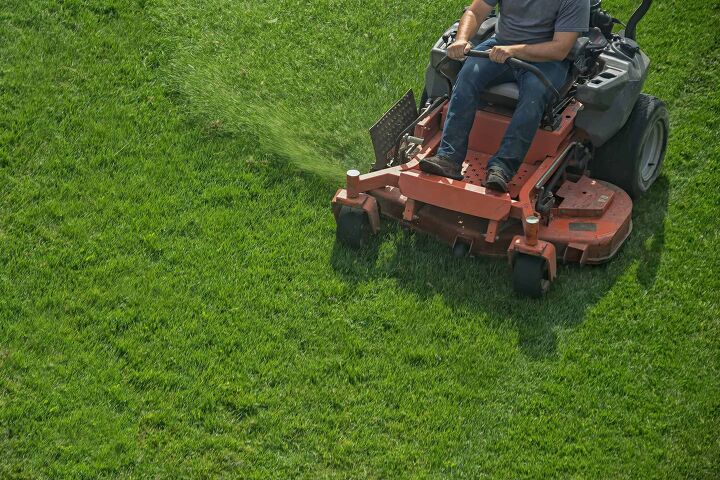How To Replace The PTO Clutch On A Scag Mower

Because lawnmowers are intricate pieces of machinery, they require upkeep and regular maintenance. One element that has to withstand a lot of wear and tear is the clutch. This component is what drives the mower blades. So, if you have a faulty PTO clutch, it will likely need to be replaced.
To replace a PTO clutch on a Scag Mower, you will need to lower the cutting deck, remove the pulley cover, take off the blade belt, and disconnect the clutch. You’ll then have to attach the new clutch, secure it with a mounting bolt, replace the belt and pulley cover, and then put the cutting deck back in its original position.
Because there are multiple pieces to focus on during this project, we will go into further detail in this article. Also, keep in mind that you will need an assistant to do this correctly, so be sure to enlist someone’s help before starting.
Do You Need a Mower Repair Service?
Get free, zero-commitment quotes from pro contractors near you.

What You’ll Need to Replace a PTO Clutch
Fortunately, this job doesn’t require any special tools. All you’ll need is a socket wrench set, a screwdriver, and a pair of work gloves. Your assistant will also need a wrench to hold the mounting bolt in place.
Step by Step Guide to Replacing a PTO Clutch
Step One: Disconnect the Spark Plugs
Before working on your lawnmower for any reason, you should always disconnect the spark plugs. This way, you lessen the risk of an errant charge causing a glitch in the system. Since you’ll be working next to the cutting blades and belt, any movement can be dangerous.
Step Two: Lower the Cutting Deck
Since the PTO clutch drives the mower blades, you will have to lower the deck all the way to access it.
Step Three: Remove the Pulley Cover
The PTO clutch on a Scag mower connects to a pulley system that drives the blades. There is a plastic covering protecting the belt from damage, so you’ll have to take it off.
Step Four: Remove the Blade Belt
To access the clutch, you’ll have to loosen the belt and pull it off the mower. We recommend starting with the pulley side so that it’s easier to get off of the clutch.
Step Five: Disconnect the Electrical Components From the Clutch
There are two sets of wires that connect to the PTO clutch. You will have to disconnect them before removing the piece.
Step Six: Remove the Flywheel Cover and Mounting Bolt
Here is where you’ll need an assistant. There is a bolt holding the clutch in place, but it connects to the top of the mower. So, your assistant will have to keep the nut in place while you unscrew the bolt. Before doing this, your helper will have to take off the flywheel cover with a screwdriver.
Step Seven: Remove the Clutch
Once the bolt is out, you can detach the clutch from the lawnmower.
Step Eight: Install the New Clutch
Fortunately, all you have to do is reverse the previous steps. First, put the clutch in place. Next, attach the mounting bolt and have your assistant tighten the nut. Make sure that the clutch is connected correctly. It should have some give, but lock in place when you move it too far in one direction.
Afterward, you can reconnect the electrical cables and reattach the blade belt. Once all of that is done, you can replace the pulley and flywheel covers and restore the cutting deck.
Step Nine: Test the Mower
Whenever doing any kind of repairs on your lawnmower, it’s crucial to test the machine after. This way, you can be sure that you installed everything correctly and that you won’t run into problems later on.
Tips and Tricks to Replace a PTO Clutch
Since this project is relatively complicated, here are some ways to make it a bit smoother.
- Read the Manual First – Looking at the manual will tell you whether there are any unique pieces or steps on top of what we listed. Each mower may have different components, so be sure to familiarize yourself with them beforehand.
- Use a Mat or Carpet – Since you’ll have to be laying on top of the cutting deck, you want something thick and comfortable. Otherwise, you will wind up with sore spots and bruises afterward.
- Inspect the Belt and Other Components – While you’re underneath the mower, take some time to check out any of the other pieces, including the mower blades, belt, and motor. This way, you can spot any other potential problems and fix them immediately.
- Clean Your Mower – Finally, replacing a PTO clutch is the perfect excuse to clean the inside of your lawnmower. Doing this will extend the life of your parts and save time and money in the long run.
Signs That Your PTO Clutch Needs Replacing
Since this piece is so vital to the performance of your Scag Lawnmower, it’s critical to understand when the clutch is starting to fail. Here are some warning signs that a replacement will be necessary soon.
- Hard Clutch – If you notice that it’s becoming more challenging to engage the clutch while riding, there is likely a problem with the system. Not only can this make it harder to engage the blades, but it could damage the clutch even more.
- Sticky Clutch – The opposite problem is a clutch pedal that doesn’t return to its starting position immediately. If you notice that the pedal is slow to bounce back or stays engaged, you have to repair or replace the clutch ASAP. Again, an unresponsive pedal can make it harder to work and add wear and tear to the motor.
- Excessive RPMs – Normally, your lawnmower blades are spinning at a high rpm. However, if they start making more noise when engaging the clutch, it could be a sign of a faulty or worn component.
- Strange Noises – Since the clutch connects to the blade belt, any errors can cause high-pitched squeals or other sounds. As a rule, anything that sounds unnatural needs to be addressed as soon as possible.
- Sudden Loss of Power – Finally, if your blades stop working while you’re driving your lawnmower, the clutch is likely to blame.
Dangers of a Broken PTO Clutch
Once your lawnmower’s clutch starts to go out, you must replace it immediately. If not, you could experience these problems.
- Uneven Cutting – Since this component drives the blades, you could experience a choppy and rough lawn.
- Broken Belt – If the clutch is having problems, it could add wear and tear to the blade belt. Over time, these cracks can cause the belt to snap.
- Damaged Motor – If you ignore the bad clutch, it could wreak havoc on your lawnmower’s motor. In extreme cases, you may have to replace the whole engine, which can be far more expensive.
- Damaged Blades – Lawnmower blades are relatively delicate, particularly when mowing over obstacles like sticks and rocks. With a lousy clutch, your mower may stay engaged when it’s not supposed to, which can ruin the edges. In that case, you might have to replace the blades altogether.
Do You Need a Mower Repair Service?
Get free, zero-commitment quotes from pro contractors near you.

Related Questions
I replaced the clutch, but I’m still experiencing problems. What should I do?
If you inspected other parts of your mower and are still stumped, we recommend taking it to a professional workshop. They can diagnose the issue and figure out how to fix it.
Can I repair the PTO clutch instead of replacing it?
In some cases, the PTO clutch may only need some slight repairs. However, because this is an electrical device, you will need specialized equipment and excellent knowledge of how it works. While it is possible, we recommend taking it to a professional for guidance.Do all riding mowers have a PTO clutch? These days, the vast majority of models do, so this guide should be helpful in almost all cases.
Related Guides

We are a team of passionate homeowners, home improvement pros, and DIY enthusiasts who enjoy sharing home improvement, housekeeping, decorating, and more with other homeowners! Whether you're looking for a step-by-step guide on fixing an appliance or the cost of installing a fence, we've here to help.
More by Upgraded Home Team











![10 Best Electric Lawn Mowers - [2022 Reviews & Top Rated Models]](https://cdn-fastly.upgradedhome.com/media/2023/07/31/9070486/10-best-electric-lawn-mowers-2022-reviews-top-rated-models.jpg?size=350x220)




![Standard Dining Room Table Dimensions [for 4, 6, 8, 10 and 12 People]](https://cdn-fastly.upgradedhome.com/media/2023/07/31/9074335/standard-dining-room-table-dimensions-for-4-6-8-10-and-12-people.jpg?size=350x220)










